Morris & Fan. Reservoir Sedimentation Handbook
Подождите немного. Документ загружается.

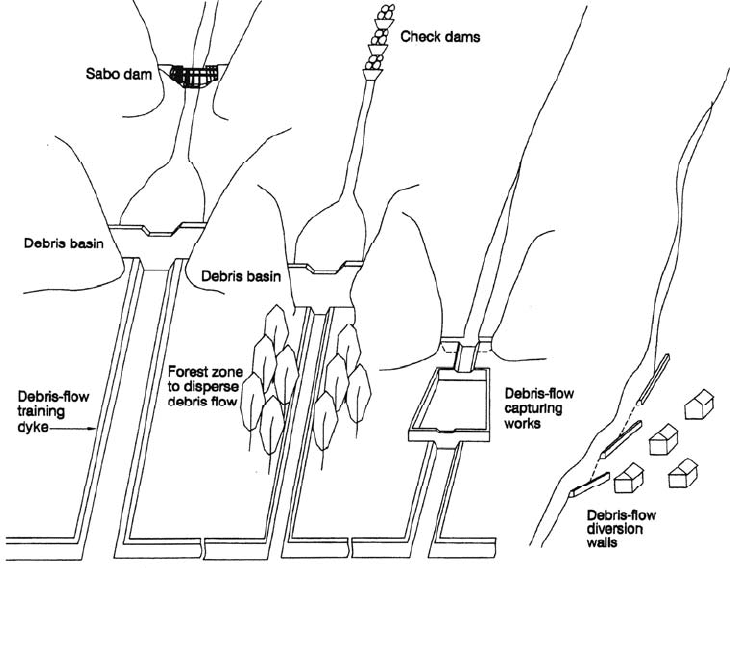
REDUCTION OF SEDIMENT YIELD 12.51
FIGURE 12.23 Strategies for the control of debris flows (modified from Mizuyama, 1993).
in southern California (Fig 12.24). Excavated basins were analyzed at this site instead
of a conventional structure because of limited space within the constricted canyon,
which was shared with a railway line, and local objections to the installation of a 13-m-
tall conventional dam-type debris basin in the canyon.
12.14.2 Sediment Trapping by Debris Basins
Unlike sediment detention basins, which seek to trap as much sediment as possible from
all runoff events, a debris basin is designed to trap only the coarse load, or only the
hyperconcentrated load associated with debris flows. To efficiently trap only a selected
part of the total load, debris basins tend to be hydrologically small with very low
capacity:inflow ratios. Debris basins have limited sediment storage capacity, and the
accumulated sediment must be removed if they are to provide long-term protection. An
oversized basin which traps the target grain size, plus a large volume of finer sediment,
is undesirable; it will increase the volume and cost of sediment removal.
Debris basin design is a three-step process: (1) determine the critical sediment size
or other critical aspect of the inflowing sediment load that should not be exceeded during
the design event for the downstream conveyance system to work properly, (2) determine
the grain size distribution and volume of the inflowing load, and (3) determine the
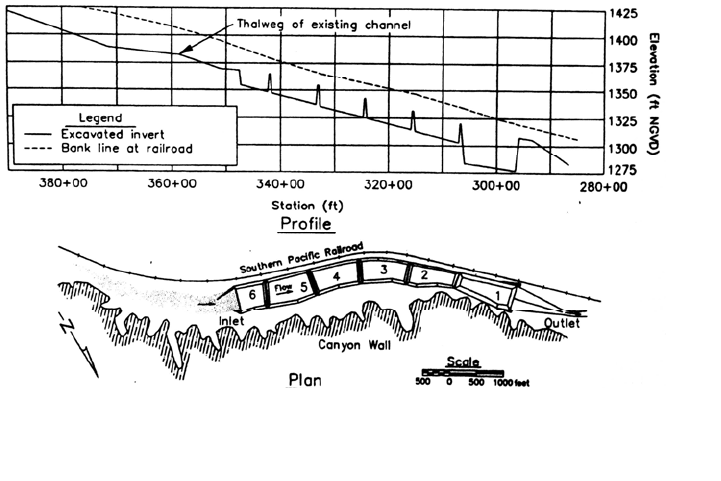
REDUCTION OF SEDIMENT YIELD 12.52
FIGURE 12.24 Plan and profile of in-channel debris basin (Stonestreet, 1992).
hydraulic characteristics of the basin required to trap the target grain size without
excessive trapping of finer material. Because debris basins may be designed to protect
against a variety of hazards, there is no "standard" design technique.
The critical grain size will be determined from sediment transport studies and modeling of
downstream channels. The loading on a debris basin may be derived from either
watershed processes or channel processes. In southern California, debris flows are most
likely to be associated with heavy rainfall on recently burned hillsides, which causes either
extreme sediment loads or slope failures. In this case the debris yield is primarily a
function of watershed processes rather than stream hydraulics. Sediment yield data and past
experience in southern California indicate that the single-event debris yield is the critical design
condition in this environment, rather than long-term accumulation. A method to compute
single-event debris yield in this region has been presented by Gatwood et al. (1992). This
method is based on a multiple linear regression developed from historical debris yield
measurements and the following parameters: relief ratio, drainage area, unit peak flow or 1-
hour precipitation, and a fire factor. In other environments the sediment to be trapped may
consist of bed material and may be modeled on the basis of stream hydraulics. Woody debris
may be important in some regions, and absent in others. Determination of debris loadings
depends heavily on information from past experience. Volcanic activity can produce extreme
sediment loads and require unique designs (U.S. Army, 1986).
Once the sediment load has been determined, the actual hydraulic performance of the
basin can be modeled by numerical modeling tools. For instance, the HE-6 model was
used to analyze the sediment-detention characteristics of the excavated debris basins
shown in Fig. 12.24 for a 100-year design event.
The debris storage volume will depend on the size of the design event and the cleanout
interval. Debris basins should be designed to provide protection during the largest design
event, and should be cleaned regularly, or when accumulated sediment occupies a
predetermined fraction of the design sediment storage volume (e.g., 25 percent). Therefore, in
most instances the issue of deposition above the spillway elevation is not an important
consideration. However, in an analysis of fully sedimented Japanese dams designed to
trap debris flows, Maita (1993) found that the stable slope of the deposits upstream of the
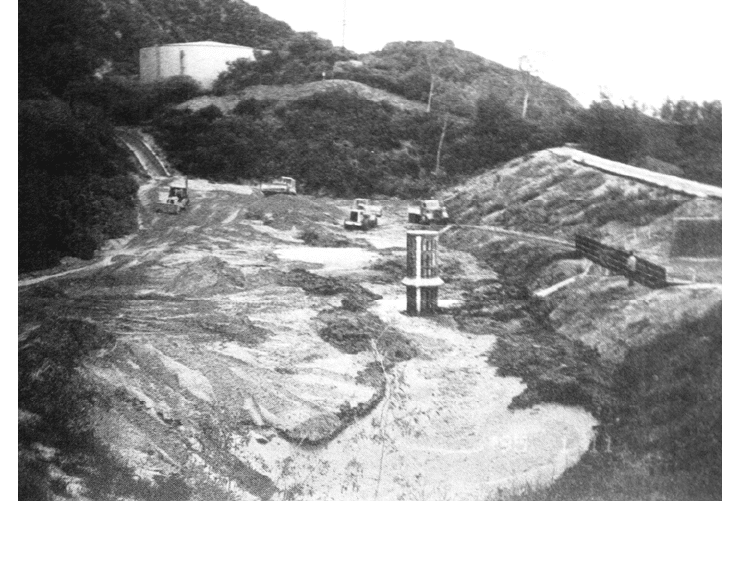
REDUCTION OF SEDIMENT YIELD 12.53
dam was usually one-half to two-thirds the original stream slope. During an extreme
sediment-transporting event, the slope will steepen and the sediment will accumulate
above the already-filled structure, whereas smaller subsequent events which deliver less
sediment from upstream will tend to scour the deposits, reducing the slope above the dam.
Under this condition even "fully sedimented" structures may provide some residual
sediment trapping during critical large events.
12.14.3 Debris Basin Cleanout
There are two basic alternatives for accomplishing debris basin cleanout: mechanical
removal and hydraulic removal. Debris basins are generally designed as normally dry
impoundments with some type of dewatering outlet. Mechanical sediment removal is
normally done with conventional earth moving equipment after the sediment has
dewatered, and the excavated sediment is used for fill (Fig. 12.25). Cost data for debris
basin cleanout presented in Table 16.1 show that costs can vary widely as a function of
both the sediment volume and the haul distance.
For hydraulic removal, the sediment which accumulates during a large event would
be removed by emptying and flushing during smaller events. In mountainous areas of
Japan threatened by hyperconcentrated debris flows, Mizuyama (1993) reports that
considerable emphasis is being given to the construction of sabo dams, which are dams
consisting of concrete abutments with an open steel framework in the central portion
(Fig. 12.26). The steel grid is spaced to provide sufficient retardance to hold back the
debris flow, while allowing smaller flows to pass through the structure without
accumulating sediment. This alternative was found to be superior to conventional
concrete gravity structures, which had the disadvantage of filling with sediment from
smaller runoff events prior to the arrival of a large debris flow.
FIGURE 12.25 Cleanout of a debris basin operated by Los Angeles County, California. Note
the perforated riser for drainage of the basin (M. Bolander).
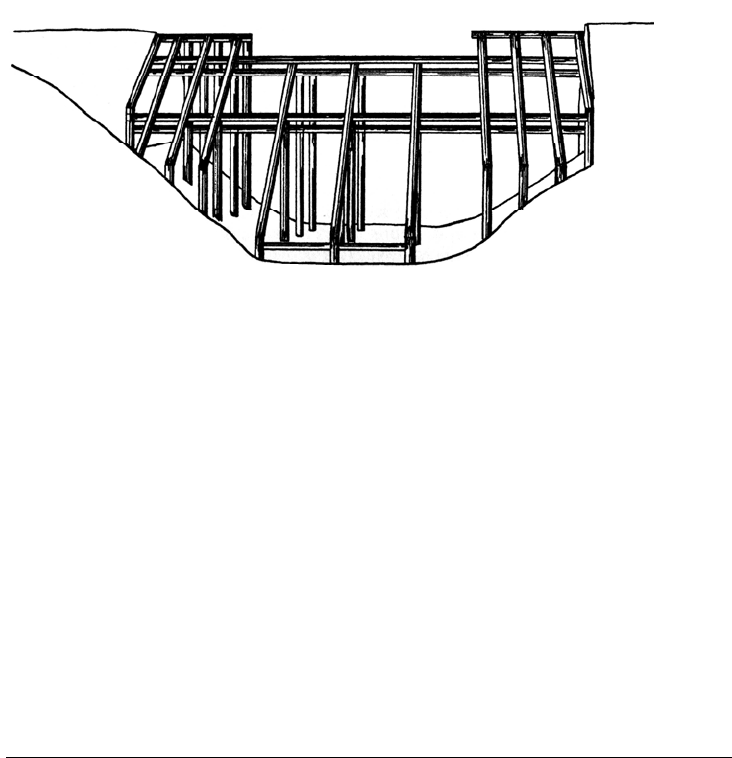
REDUCTION OF SEDIMENT YIELD 12.54
Although the hydraulic removal of accumulated debris is conceptually attractive, it
has important impediments. First, the fraction of the deposit that can be removed will
depend heavily on the reservoir geometry. Erosive flows will create a flushing channel
through the deposits, and the long-term storage capacity that can be maintained will be
limited to the volume of the flushing channel. In a narrow debris basin much of the
original capacity might be recovered by flushing, but in a broad basin the flushing
channel may comprise only a small percent of the original volume. Flushing is
discussed in Chap. 15. Second, there may also be downstream limitations. Sediment
eroded from the debris basin may be redeposited further downstream, which may be
objectionable for operational or environmental reasons.
12.15 CLOSURE
FIGURE 12.26 Open sabo-type dam used in Japan to control debris flows. The open
structure in the middle of the dam is sized to arrest the motion of a large debris flow, but
to pass smaller events. This prevents premature sedimentation of the storage basin
(redrawn from Mizuyama, 1993).
Long-term sediment yield is heavily influenced by two factors: the construction of
upstream reservoirs which trap sediment, and land use practices in the tributary
watershed. Many less developed areas of the world, especially in the tropics, are
experiencing a startling degradation of their forest and land resources, and travelers in these
regions will be struck by the paucity of soil and water conservation practices. Deforestation,
erosion, and degradation stalk the landscape, and in many areas it would seem that erosion
will be controlled only when the supply of erodible soils is exhausted. The destruction of
even the Amazon, shrouded in the smoke of its burning trees, would seem to be only a
matter of time.
In an article aptly titled "An Explosion of Green," McKibben (1995) argues that one
of the most dramatic environmental phenomena of this century has been the reforestation
of the eastern United States, following more than a century of land degradation. A cleric
traveling the 380 km route from New York to Boston in the early nineteenth century
reported that not more than 30 km of forest had withstood the assaults of farmers and
loggers. Today this same corridor is remarkable for its abundance of trees.
Reforestation of the eastern United States has been largely accidental; it is nature's
response to the abandonment of farming, especially on sloping soils. Important
contributing factors include increasing agricultural productivity on better (flatter) soils,
the development of large-scale irrigation projects in the western deserts, increasing
REDUCTION OF SEDIMENT YIELD 12.55
employment opportunities in the urban/industrial economy which drew workers away
from the farms, and a reduction in the population growth rate as the nation passed through
the demographic transition. Land use changes, coupled with soil conservation efforts on
all types of land use, enable the eastern United States to support today a larger
population at a much higher standard of living than it did during the nineteenth century,
while also sustaining a much larger forested area and generating much less soil erosion.
A transition of this type is hopefully not impossible to achieve in many of today's
developing economies. But if achieved, factors such as population control and socioeconomic
transformation will probably be of greater importance than soil conservation itself. Any soil
conservation work that helps to promote this transition will be doubly effective.
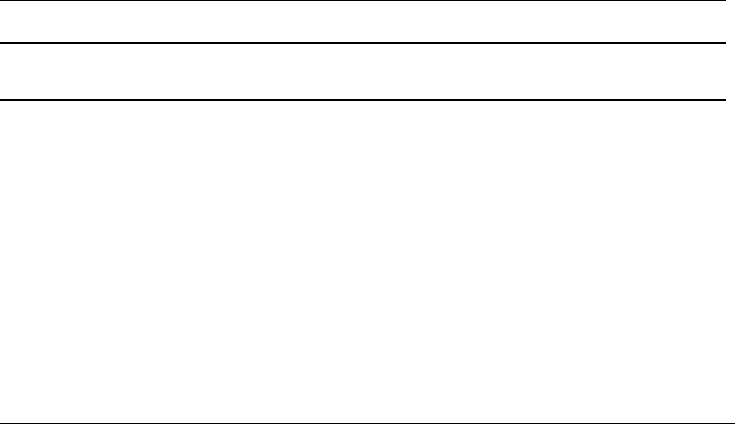
CHAPTER 13
SEDIMENT ROUTING
13.1 CONCEPT AND APPLICATION
13.1.1 Overview
Sediment routing includes any method to manipulate reservoir hydraulics, geometry, or
both, to pass sediment through or around storage or intake areas while minimizing
objectionable deposition. The sediment load in a stream is highly variable in time and can
also vary significantly within the stream cross section; most inflowing sediment is
contained in only a fraction of the inflowing water. Routing techniques seek to identify the
sediment-laden portion of the inflow, and to manage it differently than clear water inflow
to prevent, minimize, or focus sediment deposition.
Although some routing procedures may involve reservoir emptying, they are funda-
mentally different from flushing techniques, which also involve reservoir emptying.
Sediment routing focuses on either minimizing deposition or balancing deposition and
scour during flood periods, whereas flushing removes accumulated sediments after they
have been deposited. Routing preserves the timewise pattern of sediment transport along
the stream, whereas flushing modifies it significantly. The operational strategies and
consequences of reservoir drawdown or emptying under the two methods are quite distinct
and should not be confused.
13.1.2 Classification of Techniques
The storage area being protected from sedimentation may be located in the original stream
channel, off-channel, or in permeable subsurface deposits created in the impoundment
from which water may be extracted by drains or wells. Sediment routing techniques may
be classified into the following categories:
Sediment Pass-Through
1. Seasonal drawdown
2. Flood drawdown by hydrograph prediction
3. Flood drawdown by rule curve
4. Venting turbid density currents

SEDIMENT ROUTING 13.2
Sediment Bypass
1. On-channel storage
2. Off-channel storage
3. Subsurface storage
Routing techniques may also focus sediment deposition within selected areas of the
impounded reach to minimize their interference with beneficial uses or to facilitate their
subsequent removal. This chapter describes all routing techniques except density current
venting, which is covered in Chap. 14.
Concepts of sediment bypass and sediment pass-through are compared in Fig. 13.1.
The concept of sediment routing is summarized by the Chinese slogan, "Discharge the
muddy water, impound the clear water." Of the four techniques classified as pass-through,
three involve reservoir drawdown to maximize flow velocity to pass sediment through the
impounded reach without deposition. The key distinguishing characteristic among the
three drawdown techniques is the method of hydraulic control. Seasonal drawdown
involves prolonged drawdown or emptying of the reservoir for periods of weeks or
months, typically based on a calendar schedule. In contrast, the two flood drawdown
procedures involve lowering of water level or operation of gates only during flood events.
Density current venting does not require drawdown, but releases turbid underflow from
low-level outlets at the dam.
From among the case studies, Sanmenxia, Heisonglin, Cachi, Gebidem, and SefidRud
all employ reservoir emptying for sediment management. Sanmenxia is an example of
sediment routing because the reservoir is empty during the flood seasons, with the primary
emphasis placed on passing sediment through the impoundment without deposition.
Heisonglin represents a combination of routing plus flushing; although emptying occurs
during flood season, the detention and resultant sediment deposition imposed by the low
discharge rate requires that flushing techniques also be employed to preserve capacity. At
Cachi and Gebidem, only flushing is performed because reservoir emptying is not
synchronized with flood inflow, and sediment management aims to remove sediment after
it has been deposited. The Loiza and Feather River case studies (Chaps. 20 and 22) are
examples of sediment routing in reservoirs that are not emptied.
13.1.3 Advantages and Disadvantages
Sediment routing partially preserves the natural sediment-transport characteristics of the
river, whereas flushing usually changes these characteristics dramatically. Generally
speaking, routing is the most environmentally benign sediment management strategy,
while flushing is potentially the most damaging. Some routing techniques can transport
coarse as well as fine sediments beyond the dam, largely eliminating the impacts to
streambed profile. At some sites routing can be implemented at very low cost, but at others
FIGURE 13.1 Classification of sediment routing strategies.

SEDIMENT ROUTING 13.3
costly modifications to the dam will be required to provide large-capacity low-level
outlets.
A major disadvantage of sediment routing is that a significant amount of water must be
released during floods to transport sediments. Sediment routing is most applicable at
hydrologically small reservoirs where the water discharged by large sediment-transporting
floods exceeds reservoir capacity, making water available for sediment release without
infringing on beneficial uses. Some routing operations require the use of real-time
hydrologic forecasting. Sediment routing may not be able to remove previously deposited
sediment or pass the coarsest part of the inflowing load beyond the dam. Thus, routing
needs to begin as early as possible after dam construction to preserve capacity, and
supplemental measures (e.g., flushing, dredging) may also be required.
13.2 SEDIMENT PASS-THROUGH BY SEASONAL
DRAWDOWN
13.2.1 Technique
A reservoir operated under seasonal drawdown is either partially or completely emptied
during the flood season. Seasonal drawdown is conducted during a predetermined period
each year, as opposed to flood routing, which requires that the reservoir level be drawn
down to pass individual flood events whenever they occur.
13.2.2 Partial Drawdown
Under partial drawdown, the reservoir is maintained at a lower pool elevation during the
flood season to increase flow velocity and decrease detention time and sediment trapping.
The pool may temporarily be drawn down even further to route specific events through the
impoundment. Sediment release efficiency is determined by the sediment transport
capacity along the full length of the impoundment, including any backwater area in front
of the dam which will accumulate sediment until an equilibrium profile is established.
Under appropriate conditions, a sediment balance can be achieved with year-round
uninterrupted reservoir operation by using partial drawdown.
13.2.3 Partial Drawdown at Three Gorges Project
An example of partial drawdown is the Three Gorges Project (TGP) on the Yangtze River
in China. General project information is described by Changjiang Water Resources
Commission (1994) and Lu (1995), and sedimentation issues have been described by Lin
et al. (1989, 1993) and Chen (1994).
Construction of the controversial Three Gorges Project began in 1993 and is projected
to require 17 years. When completed it will be the world's largest hydropower project with
18,200 MW of installed capacity in 26 generating units of 700 MW powered by Francis-
type turbines rated at 940 m
3
/s with minimum and maximum operating heads of 71 and
113 m, respectively. Many aspects of the project are both massive and extremely
challenging. The concrete gravity dam, powerhouse, and locks will require over 100 Mm
3
of rock and earth excavation, 30 Mm
3
of embankment construction, and 27 Mm
3
of
concrete. At 175 m, the dam is not unusually tall, but it must be constructed across a river
60 m deep with a mean discharge of 14,300 m
3
/s. The 1084 km
2
reservoir area will

SEDIMENT ROUTING 13.4
submerge 632 km
2
of upland area, of which 278 km
2
is agricultural land, and will require
the relocation of over 1 million people. In addition to hydropower production, it is
designed to provide 22 km
3
of flood control storage, and to enhance navigation upstream
of the dam by submerging rapids and downstream of the dam by increasing minimum
flows from around 2770 m
3
/s to over 5000 m
3
/s.
A primary design objective is to achieve long-term sustainable use. This requires that
sedimentation be managed to prevent long-term loss of storage capacity in the flood
control pool, to enable continued navigation along the entire length of the reservoir by
10,000-ton tows, and to minimize sediment entrainment into the turbines and
accumulation in the vicinity of navigation locks at the dam. The navigation criteria require
continuous maintenance of a channel along the entire length of the reservoir at least 3.5 m
deep, 100 m wide, and having a minimum radius of curvature of 1000 m. These objectives
are achieved by constructing a hydrologically small reservoir and operating in a seasonal
drawdown mode. Design and operational parameters were analyzed in numerous physical
and numerical sediment transport modeling studies performed over a period of decades.
Despite its large absolute total storage capacity of 39 km
3
, the TGP reservoir is
hydrologically small compared to the 451 km
3
annual discharge of the Yangtze River; it
has a capacity:inflow ratio of only 0.087. The 600-km-long reservoir will not exceed 1 km
in width along 85 percent of its length, and will have a maximum width of about 1.7 km
(Fig. 13.2). Thus, the reservoir will continue to be confined within the narrow Yangtze
gorge and most places will be narrower than the equilibrium channel width, esti-
Natural lakes characteristically have relatively small drainage areas contributing,
FIGURE 13.2 Plan view of Three Gorges Project reservoir, currently under construction
(afterLinet al.,1989).
mated at 1300 m
. The Three Gorges Project differs from the Sanmenxia Dam on the
Yellow River, which experienced severe sedimentation problems, in that sediment con-
centration on the Yangtze averages only 1.2 g/L, as opposed to 37 g/L on the Yellow
River, and the discharge of the Yangtze is about 10 times larger than that of the Yellow
River. In the TGP reach the Yangtze River transports 526×10
6
t/yr of suspended sediment
with a median diameter of 0.033 mm, plus 8.6×10
6
t/yr of bed load.
A flood control and sediment routing level of 145 m will be maintained during the wet
season and a normal pool level of 175 m will be maintained during the remainder of the
year to provide increased head for power production (Fig. 13.3). The lowered reservoir
level during the flood season not only empties the flood control pool, but is also required
to generate the flow velocity necessary to route sediment through the reservoir.
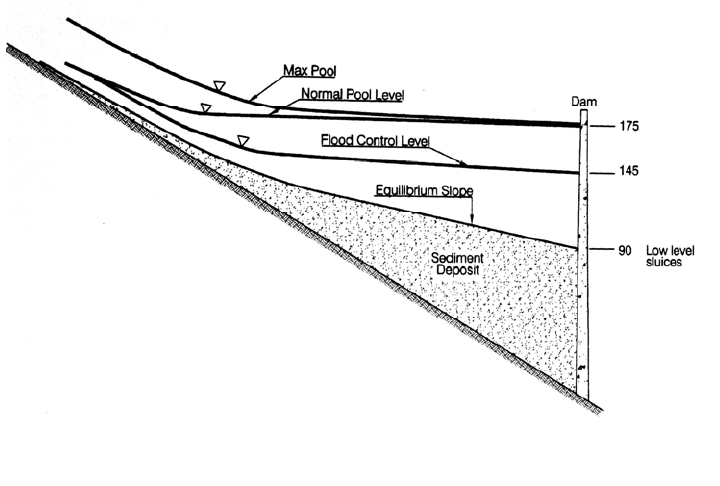
SEDIMENT ROUTING 13.5
FIGURE 13.3 Three Gorges Project on Yangtze River in China, showing the routing profile
(modified from Lin et al., 1989).
The dam has been designed with 23 low-level bottom outlets at an elevation of 90 m
and 22 high-level sluices at an elevation of 158 m, in addition to penstocks, and will be
able to discharge 60,900 m
3
/s at a pool elevation of 145 m. The maximum discharge
capacity of the dam is 116,000 m
3
/s.
The flood season, from June to September, accounts for 61 percent of the river
discharge and 88 to 90 percent of the annual sediment load. High velocities created by the
low pool elevation will pass sediment finer than 0.01 mm through the reservoir pool
without deposition, and will also allow the development of an equilibrium bed profile that
will preserve between 85 and 92 percent of the original storage capacity. The reservoir
will have very little effect on the shape of the hydrograph, passing both water and
sediment in a seasonal pattern very similar to natural conditions (Fig. 13.4). Preservation
of the natural hydrograph is a key feature of sediment routing, and may be contrasted to
hydrographs of flushing presented in Fig. 15.1. After approximately 100 years, the
inflowing load and the sediment discharged from the dam are expected to reach
equilibrium with respect to both total amount of sediment and grain size distribution.
However, there will be variations in the pattern of sediment deposition and scour from one
year to another. Simulations have shown that large floods can be expected to deposit
sediment in the backwater reach, but in the subsequent year this deposit will be scoured
from the upstream reach and moved closer to the dam until discharged through the low-
level outlets. If unanticipated deposition occurs, the large capacity of the low-level outlets
(51,780 m
3
/s at 130-m pool elevation) will allow additional drawdown to promote
scouring of deposits.
Sediment passage through the dam will help offset bed degradation in the downstream
reach. Initially the reservoir will trap bed material, causing channel degradation below the
dam, until limited by the formation of a gravel armor layer. After approximately 60 years,
the combination of armoring and increased bed material discharge through the dam is
expected to halt and possibly reverse downstream degradation. However, significant
aggregate mining is occurring in the channel below the dam, which may deplete armor-
size material and increase downstream bed degradation.
Drawdown will not solve all sediment-related problems. Gravels will continue to
accumulate in the impounded reach and will need to be dredged, but the amount is antici-
